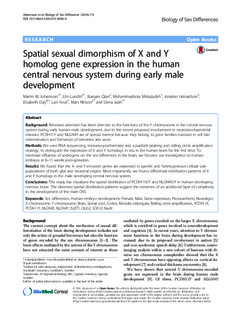| dc.contributor.author | Johansson, Martin | |
| dc.contributor.author | Lundin, Elin | |
| dc.contributor.author | Qian, X | |
| dc.contributor.author | Mirzazadeh, Mohammadrexa | |
| dc.contributor.author | Halvardson, Jonatan | |
| dc.contributor.author | Darj, Elisabeth | |
| dc.contributor.author | Feuk, Lars | |
| dc.contributor.author | Nilsson, M | |
| dc.contributor.author | Jazin, Elena | |
| dc.date.accessioned | 2020-03-02T07:46:52Z | |
| dc.date.available | 2020-03-02T07:46:52Z | |
| dc.date.created | 2016-03-13T18:44:01Z | |
| dc.date.issued | 2016 | |
| dc.identifier.citation | Biology of Sex Differences. 2016, 7 (5), . | nb_NO |
| dc.identifier.issn | 2042-6410 | |
| dc.identifier.uri | http://hdl.handle.net/11250/2644518 | |
| dc.description.abstract | Background
Renewed attention has been directed to the functions of the Y chromosome in the central nervous system during early human male development, due to the recent proposed involvement in neurodevelopmental diseases. PCDH11Y and NLGN4Y are of special interest because they belong to gene families involved in cell fate determination and formation of dendrites and axon.
Methods
We used RNA sequencing, immunocytochemistry and a padlock probing and rolling circle amplification strategy, to distinguish the expression of X and Y homologs in situ in the human brain for the first time. To minimize influence of androgens on the sex differences in the brain, we focused our investigation to human embryos at 8–11 weeks post-gestation.
Results
We found that the X- and Y-encoded genes are expressed in specific and heterogeneous cellular sub-populations of both glial and neuronal origins. More importantly, we found differential distribution patterns of X and Y homologs in the male developing central nervous system.
Conclusions
This study has visualized the spatial distribution of PCDH11X/Y and NLGN4X/Y in human developing nervous tissue. The observed spatial distribution patterns suggest the existence of an additional layer of complexity in the development of the male CNS. | nb_NO |
| dc.language.iso | eng | nb_NO |
| dc.publisher | BioMed Central | nb_NO |
| dc.relation.uri | http://www.karger.com/Article/FullText/442250 | |
| dc.rights | Navngivelse 4.0 Internasjonal | * |
| dc.rights.uri | http://creativecommons.org/licenses/by/4.0/deed.no | * |
| dc.title | Spatial sexual dimorphism of X and Y homolog gene expression in the human central nervous system during early male development | nb_NO |
| dc.type | Journal article | nb_NO |
| dc.type | Peer reviewed | nb_NO |
| dc.description.version | publishedVersion | nb_NO |
| dc.source.pagenumber | 17 | nb_NO |
| dc.source.volume | 7 | nb_NO |
| dc.source.journal | Biology of Sex Differences | nb_NO |
| dc.source.issue | 5 | nb_NO |
| dc.identifier.doi | 10.1186/s13293-015-0056-4 | |
| dc.identifier.cristin | 1344131 | |
| dc.description.localcode | Open Access This article is distributed under the terms of the Creative Commons Attribution 4.0 International License (http://creativecommons.org/licenses/by/4.0/), which permits unrestricted use, distribution, and reproduction in any medium, provided you give appropriate credit to the original author(s) and the source, provide a link to the Creative Commons license, and indicate if changes were made. The Creative Commons Public Domain Dedication waiver (http://creativecommons.org/publicdomain/zero/1.0/) applies to the data made available in this article, unless otherwise stated. | nb_NO |
| cristin.unitcode | 194,65,20,0 | |
| cristin.unitname | Institutt for samfunnsmedisin og sykepleie | |
| cristin.ispublished | true | |
| cristin.fulltext | original | |
| cristin.qualitycode | 1 | |

